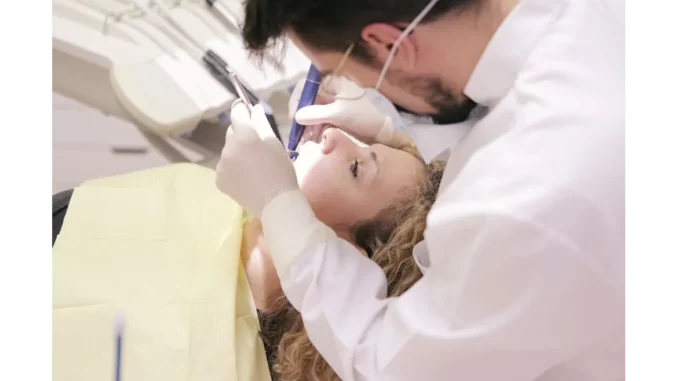
The rapid evolution of artificial intelligence (AI) is reshaping various industries worldwide, and dentistry is swiftly aligning with this transformation. In the quest to understand how AI is revolutionising dental care, I engaged in a compelling conversation with Dr Emma Clarkson, a distinguished dentist and advocate for technological advancement. Our discussion illuminated the profound impact AI is having on dental practices, highlighting its potential to enhance precision and efficiency while underscoring the irreplaceable value of human expertise.
The recent “AI in Dentistry and Oral Health” conference, hosted by the Faculty of Dental Surgery at the Royal College of Surgeons of England, provided the backdrop for our exchange. Dr Clarkson, an attendee of the conference, was eager to share her experiences and insights. “AI in dentistry is no longer a futuristic concept; it is becoming a tangible part of our reality,” she explained. “Its applications span diagnosis, treatment planning, monitoring, and even administrative tasks, promising a future where dental care is more precise and efficient.”
Dr Clarkson elaborated on the conference’s dynamic environment, curated by Professor Andrew Eder, which brought together experts from various sectors, including clinicians, entrepreneurs, and academics. “It was a melting pot of ideas,” she observed. “With an increased focus on technology adoption within public services, the timing was impeccable. There was an overwhelming sense of urgency and optimism in the air.”
Highlights of the conference included a presentation by Dr Peter Thomas, a paediatric ophthalmologist, who drew compelling parallels between ophthalmology and dentistry. “Ophthalmology is a forerunner in AI utilisation,” Dr Clarkson noted. “Their success with digital innovations like video consultations and virtual clinics serves as a beacon for other medical fields, offering valuable insights for the integration of AI in dentistry.”
Another pivotal session, led by Professor Andrew Keeling, addressed the integration of AI in dental practices. Dr Clarkson praised his transition from software engineering to dentistry, which exemplifies the convergence of technology and healthcare. She explained, “His work with digital facebows and optical tracking devices is revolutionising occlusal examinations, making intricate tasks more approachable and precise through AI.”
The conference also spotlighted AI-powered software for detecting dental diseases, spearheaded by Dr Yunpeng Li. “The development of tools for robust X-ray analysis is a significant advancement,” Dr Clarkson commented. “AI’s capacity to discern normal from abnormal structures in radiographs offers invaluable support to dentists, enhancing diagnostic accuracy.”
Despite these advancements, Dr Clarkson cautioned against overlooking the crucial role of human judgement. “AI is exceptionally analytical, but it cannot replicate the nuanced understanding of a skilled dentist,” she warned. “Dr Hannah Burrow’s insights on this matter were particularly impactful; while AI offers generalised solutions, it is our responsibility to adapt them to meet individual patient needs.”
Orthodontics appears to be a frontrunner in AI adoption, according to Dr Clarkson. She cited Dr Asif Chatoo’s practice, which utilises digital processes to great effect. “AI’s application in radiology, especially cephalometric data analysis, significantly reduces time and enhances accuracy,” she said. “Remote monitoring facilitated by patient-friendly software is yet another advantage AI brings to the table.”
Discussing the revolutionary potential of AI in implant surgery, as presented by Dr Andrew Dawood, Dr Clarkson expressed her amazement. “AI’s precision in detecting radiographic features is extraordinary,” she remarked. “It paves the way for innovative treatment strategies that were previously beyond our reach.”
Reflecting on the overarching themes of the conference, Dr Clarkson emphasised the necessity of integrating AI into existing healthcare frameworks thoughtfully. “Dr Janak Gunatilleke’s insights on gaining user trust and avoiding the indiscriminate application of technology were particularly valuable,” she observed. “AI should augment our expertise, not replace it.”
The session on AI and Extended Reality (XR), led by Professors Jag Dhanda and Jamshid Dehmeshki, left a profound impact on Dr Clarkson. “Their enthusiasm for using XR in surgical training was truly inspiring,” she shared. “AI’s ability to process vast amounts of data can alleviate cognitive burdens on clinicians. However, it’s important to remember that AI aids decision-making but does not comprehend human reasoning.”
As our engaging conversation came to an end, Dr Clarkson expressed her optimism about the future of dentistry with AI at its helm. “It’s an exhilarating time to be part of this field,” she concluded. “AI holds immense promise in enhancing patient care and streamlining processes. Nevertheless, it is imperative to approach this transformation with both caution and wisdom, ensuring technology remains a valuable ally to our expertise.”
Dr Emma Clarkson’s insights provided a comprehensive look into the rapidly evolving landscape of dentistry, underscored by the transformative potential of AI. As the dental community continues to explore and integrate these innovations, maintaining a harmonious balance between cutting-edge technology and indispensable human touch remains paramount.


Be the first to comment